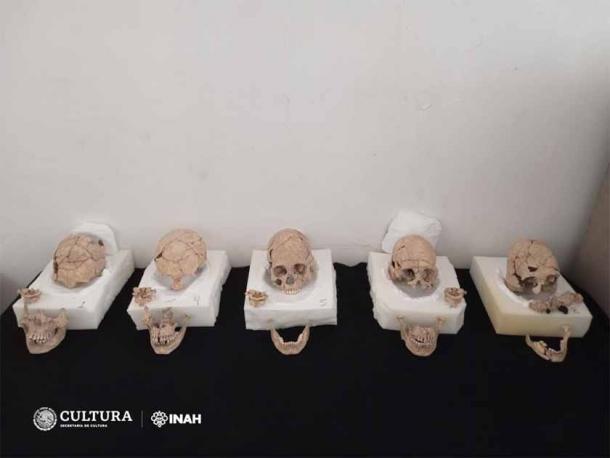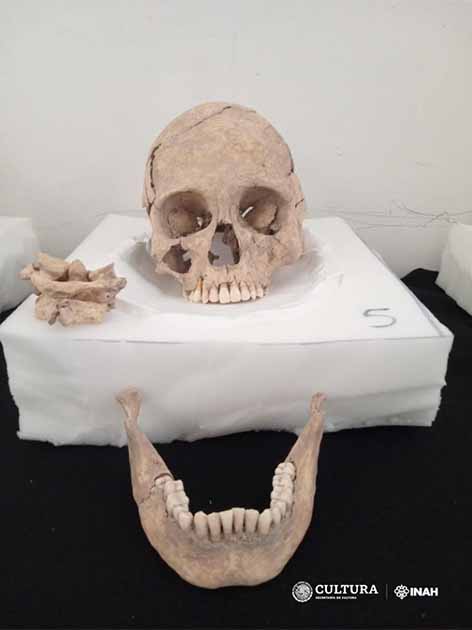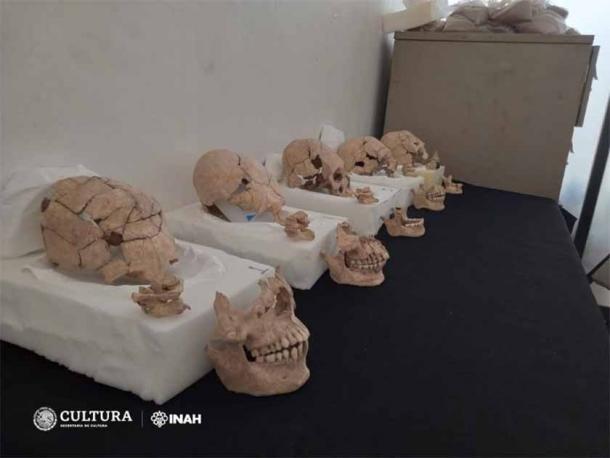In April , archaeologists working at the Moral-Reforma Archaeological site in Tabasco, Mexico, discovered 13 human burials with elongated skulls showing decapitation marks. Now, scientists and historians working at the ancient Maya site have conducted an anthropological study and ascertained that at least two of these individuals were beheaded as ritual offerings at the temple-pyramid of the eastern plaza during the Late Classic Period (600-900 AD)!
Identifying the Decapitated Finds
Indeed, one of the two skulls exhibits distinct horizontal cut marks in the craniocervical junction, which consists of the occipital bone, forming the base of the skull, and the first two upper spinal bones, according to a press release by the National Institute of Anthropology and History (INAH) . While a sharp object was used for the extraction of the skull, it remains unclear whether these injuries caused death or were post-mortem.

5 of the decapitated skulls discovered at the Maya Moral-Reforma Archaeological site in Tabasco, Mexico. (Miriam Angélica Camacho Martínez/INAH )
This site in southeastern Mexico was an ancient Maya city with an occupational history potentially stretching back to 300 BC. It became an important trading center along the San Pedro Mártir River. The settlement flourished during the mid- to late-first millennium AD, before being deserted around the year 1,000 AD.
Leading the archaeological project at this ancient Maya site, Francisco Apolinar Cuevas Reyes, highlighted that, through the Archaeological Zone Improvement Program (Promeza), supported by the federal Ministry of Culture and the National Institute of Anthropology and History, they had successfully recovered 13 burials associated with Structure 18. Miriam Angélica Camacho Martínez, a physical anthropologist from the INAH Tabasco Center, said:
“the use of a sharp object was used to extract the skull, and we know this because the cervicals and the mandible maintained their anatomical relationship, although it is difficult to determine if this injury was the cause of death or if it was done post mortem.”
Ritual Offerings, Artificial Cranial Modification, and Elevated Status
The meticulous analysis of these human remains in the laboratory conducted by Camacho Martínez includes micro-excavation, cleaning, gluing, analysis, and photographic documentation. The next phase will involve their restoration and the performance of DNA analysis and stable isotopes to reconstruct the ancestry and determine the paleodiet of those who were sacrificed.
Excavations were conducted just 12 meters (39.37 ft.) in front of the southern staircase of Structure 18, revealing these burials. The burials consisted of human skulls, jaw fragments, and bones from the upper and lower extremities. This context strongly suggested the possibility of decapitation and dismemberment of the individuals involved, reports The Heritage Daily .
Thus far, morphoscopic analysis of five skulls has been carried out. All five have been identified as male individuals. Two of them were estimated to be between 17 and 25 years old at the time of death, another pair between 33 and 45 years old, and one individual was believed to be around 25 to 35 years old, based on dental wear analysis.

One of the skulls discovered at the Moral-Reforma archaeological site. (Miriam Angélica Camacho Martínez/INAH )
It was observed that all five skulls exhibited oblique tabular type cephalic modeling, a form of artificial cranial modification and a physical trait that signified elevated status in pre-Columbian Maya society. This trait was acquired by splinting the head at an early age, leading to the development of hyperostosis or excessive bone growth in all cases. The burials were possibly arranged in a certain depth and style intended as offerings to Maya underworld deities.

Five skulls exhibited oblique tabular type cephalic modeling, a form of artificial cranial modification. (Miriam Angélica Camacho Martínez/INAH )
In terms of health and nutrition indicators, dental pathologies were identified, including a defect known as enamel hypoplasia in canines, which suggests 𝘤𝘩𝘪𝘭𝘥hood malnutrition or early infections. Tartar plaque was found on upper and lower incisors, along with cavities in three of them, indicating a diet likely based on carbohydrates, probably corn, reports The Newsweek . Another distinctive feature among the burials was the presence of red pigment covering some of them – ongoing analysis will reveal more about this discovery.
The recent field season at Moral-Reforma has been highly productive, revealing human burials offered during both the Late Classic and Late Preclassic periods, spanning from 300 BC to 250 AD, in both Structure 18 and residential areas. In total, 44 burials have been discovered, and archaeologists believe they are far more waiting to be uncovered.





